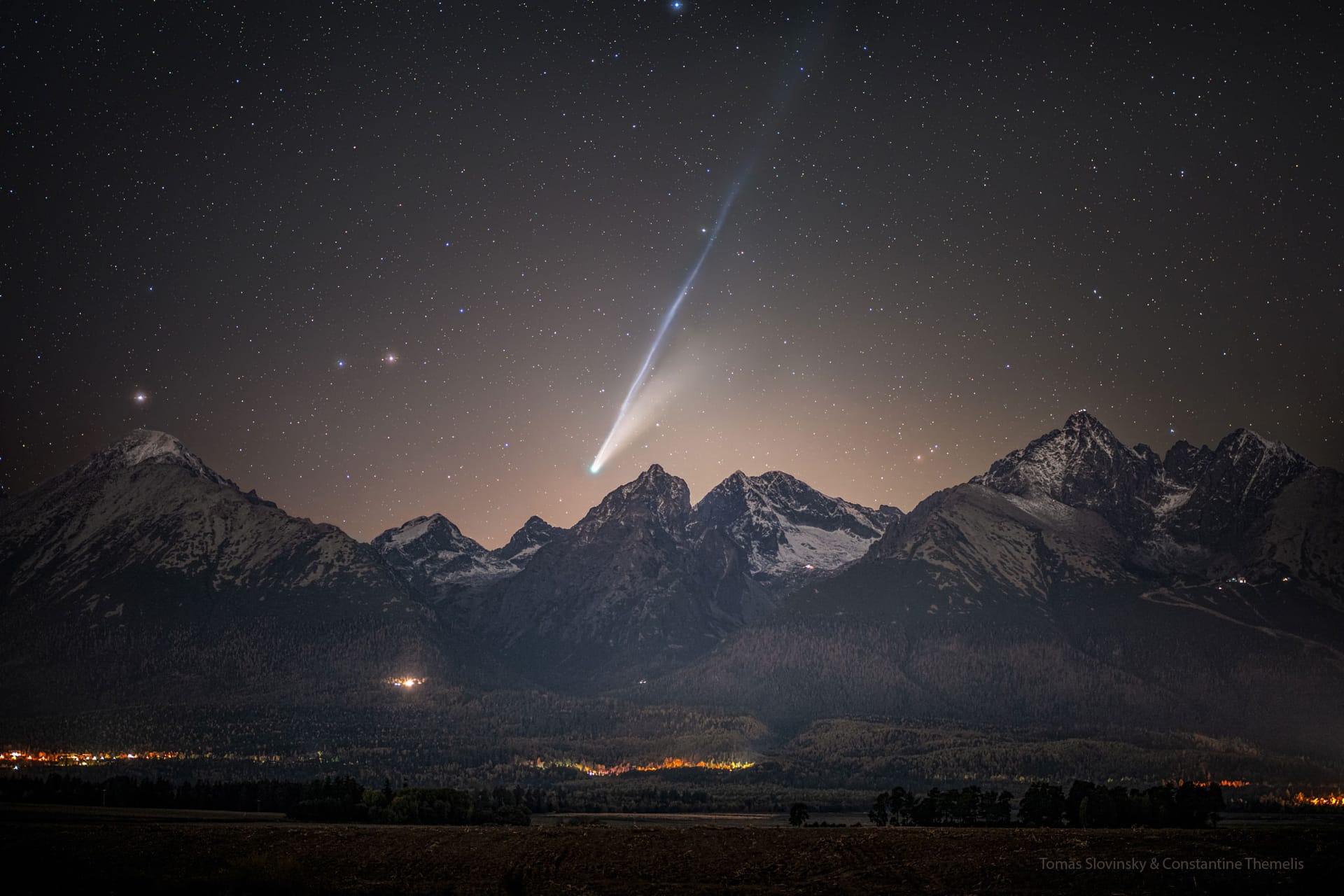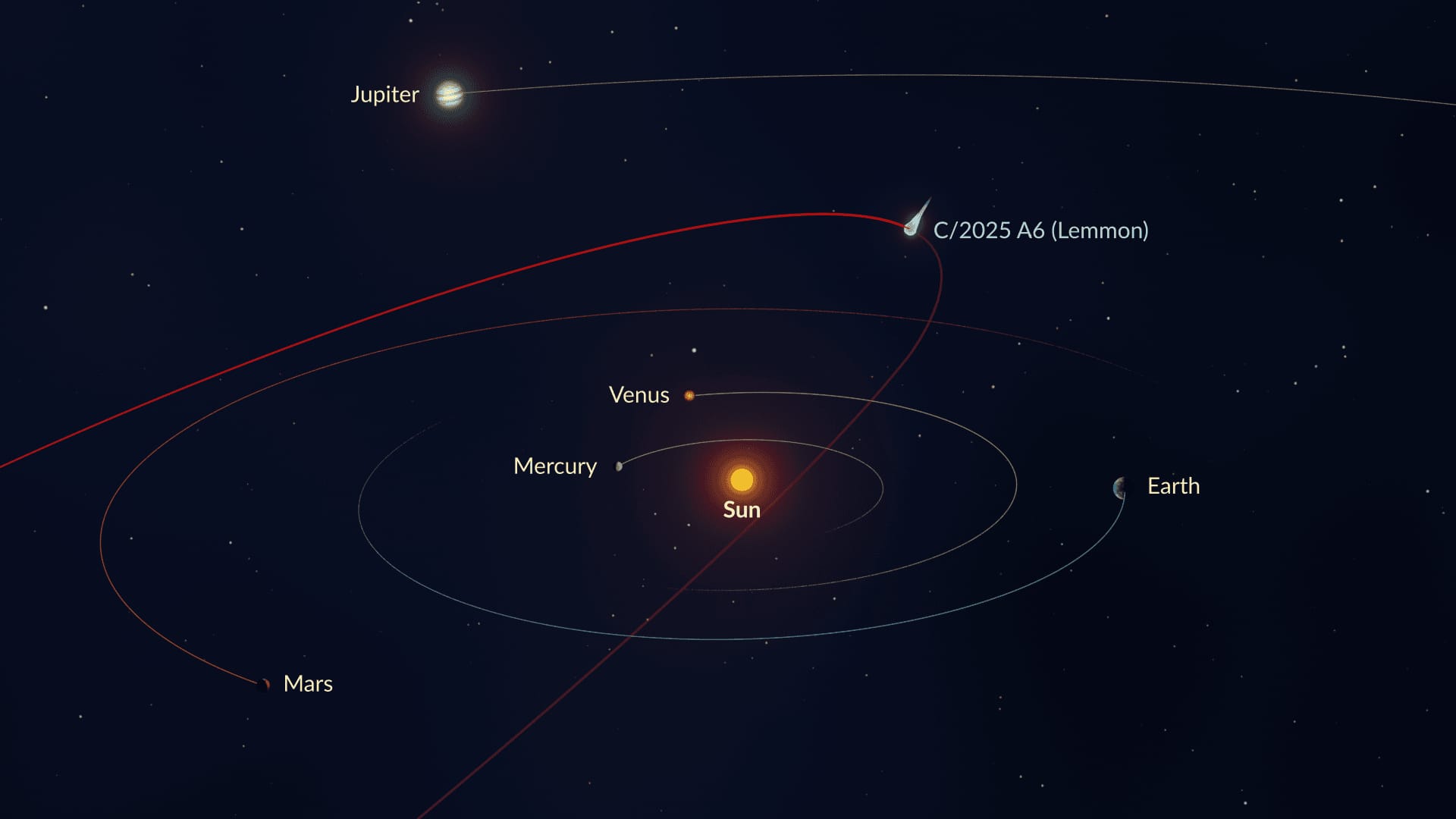Say Goodbye to Comet Lemmon — the Brightest Comet of 2025
Comet Lemmon is now slipping away from our Solar System, and it’s time to say goodbye. Brighter than 90% of the comets that visit our cosmic neighborhood, it was admired by thousands of astronomy enthusiasts around the world — but its glow is now fading. Track Comet Lemmon’s path in the sky with the Star Walk 2 app. Keep reading to learn more about this unforgettable celestial visitor — the best comet of 2025!
Contents
- Comet Lemmon 2025 Explained: Key Facts and Visibility Guide
- Comet Lemmon Photography Tips: Guide for Beginners
- When and How Comet Lemmon (C/2025 A6) Was Discovered
- F.A.Q: Comet Lemmon
- All About Comet Lemmon (C/2025 A6): Summary and Highlights
Comet Lemmon 2025 Explained: Key Facts and Visibility Guide
Comet Lemmon showed up in January and suddenly became the candidate for the best comet of 2025. There are likely no other comets reaching that brightness this year.
Comet Lemmon was best visible from Earth during October and early November 2025, peaking in brightness around October 27–28. Many observers reported seeing it with the naked eye under dark, moonless skies. Astrophotographers captured stunning images of the comet, revealing a bright green coma and long, elegant tails.

On November 8, C/2025 A6 (Lemmon) made its closest approach to the Sun and has since begun its journey out of the Solar System. This truly was a once-in-a-lifetime event — Comet Lemmon won’t return for roughly another 1,000 years, meaning no one alive today will ever see it again. The comet was best viewed from the Northern Hemisphere — another rare detail. The orbit of C/2025 A6 is tilted by 143.7°, so the comet moves retrograde — opposite the planets’ usual direction — and approached perihelion on a northern, retrograde path, favoring northern observers.

Now, another comet is stealing the spotlight — the third confirmed interstellar object, 3I/ATLAS. Is it just another comet, or something more mysterious? Some even wonder if it could be an alien spaceship. Find out the truth in our dedicated article.
How Bright Did Comet Lemmon Get in 2025?

Let’s talk about numbers. In astronomy, magnitude values work as follows: the lower the number, the brighter the object.
In late October, around peak brightness, Comet Lemmon reached magnitude 4, and became a naked-eye object from dark locations and an easy target in binoculars.
But despite being the best comet of 2025, Comet Lemmon didn’t become a “great” comet, like NEOWISE or (arguably) Tsuchinshan-ATLAS. However, this comet is still way brighter than about 90% of comets visiting our Solar System.
To locate Comet C/2025 A6 in the sky, use any astronomical app, like Star Walk 2 or Sky Tonight. This way, finding the comet will only take you a few seconds.
Is Comet Lemmon Visible to the Naked Eye?
Comet Lemmon was visible without binoculars: starting around October 20, people from different parts of the world reported that the comet became bright enough to spot with the naked eye. Some observers estimated C/2025 A6 has reached a magnitude of about 3.6, though more reliable data from COBS suggested it’s closer to 4.
After reaching peak brightness on October 27–28, the comet began to fade and drift closer to the horizon. Currently, Comet C/2025 A6 isn’t visible to the naked eye and can only be seen with binoculars or a telescope.
We’d love to see the results of your observations — share your photos or impressions of the comet with us on social media.
Visibility of Comet C/2025 A6 (Lemmon) in 2025
In mid-November, C/2025 A6 (Lemmon) is visible through binoculars or a telescope from both hemispheres. Look for it in the early evening, very close to the southwestern horizon in the constellation Ophiuchus. The comet is gradually fading in the evening twilight, and by the end of the month, it will be too close to the Sun to be visible.

Comet Lemmon Photography Tips: Guide for Beginners

The comet won’t stay long — but your photos will. Comet Lemmon offered a perfect chance to practice astrophotography, visible under dark skies with a long tail stretching several degrees across the sky, making it especially rewarding to photograph.
When photographing a comet, keep two things in mind:
-
Comets move across the sky. Short exposures of a few dozen seconds won’t show much motion, but in longer sequences or stacked images, the comet’s core may slightly shift compared to the stars.
-
Dark skies matter. Light pollution and moonlight reduce contrast. For best results, choose dark conditions. The free Star Walk 2 app can help you locate the comet, check its altitude, and find the observing time when the sky is darkest.
Next, let’s explore how to capture the comet using different gear — from a smartphone on a tripod to a camera with a star tracker or even a telescope.

How to Photograph a Comet with a Smartphone
Using just your phone, Comet Lemmon will likely appear as a faint, fuzzy spot with a faintly visible tail. Still, it’s worth a try! Check out some images of Comet Lemmon made with an iPhone 15 Pro on our Instagram page.
If you can’t see Comet Lemmon with the naked eye, a picture might reveal it. Just find the comet’s location in the sky with the free Star Walk 2 app, take a picture with the right settings, and voilà! Here's how to capture it:
- Set your phone on a tripod or stable surface.
- Turn on Night mode or Astrophotography mode (available on some phones).
If your phone supports Pro/Advanced mode, adjust the settings manually. Here is a short settings guide:
- ISO (sensitivity): Use 1600–3200. Higher ISO settings make the image brighter but also add noise.
- Exposure (shutter speed): Set to 5-10 seconds. Longer exposures may blur stars and the comet.
- Aperture (f-number): Usually fixed on phones. A lower number (like f/1.8) lets in more light.
- Zoom: Stick to 1× or 2× for clarity. At 0.5× wide-angle, the comet looks too small. At 2×, it stands out more while still showing the surrounding sky. If your phone supports 3× or higher, try it for a closer view of the comet.
How to Photograph a Comet with a Camera and Tripod
This is the first step beyond smartphone photography. With this setup, you can capture either a wide-field shot of the comet in a landscape or a closer view showing the comet and its short tail.
- Lens: 14-35 mm for landscapes; 85-135 mm for closer comet shots.
- ISO: 1600-3200.
- Exposure: 10-20 seconds with a wide-angle; 5-10 seconds with a short telephoto to avoid star trailing.
- Aperture: As wide as possible (f/2-f/2.8).
- Focus: Set manually on a bright star near the comet.
Tip: The Star Walk 2 app in AR mode can help you align the comet with a landmark, such as a tree, mountain, or building, for a striking composition.
Using a Telephoto Lens or Telescope for Comet Photography
This setup lets you zoom in for a larger image of the comet’s nucleus and part of its tail. Without tracking, however, you’ll be limited to short exposures.
- Focal length: 200-500 mm telephoto lens, or a small telescope (80-100 mm aperture).
- ISO: 1600-3200.
- Exposure: Very short, 1-5 seconds to avoid smearing.
- Aperture: Around f/4-f/5, typical for telescopes.
You’ll capture a sharp cometary core with a faint hint of the tail. To reveal more detail, take multiple short frames and stack them during processing.
How to Capture a Comet with a Star Tracker
A star tracker follows the sky’s motion, allowing longer exposures that reveal faint details in the comet’s tail.
- Lens: 50-200 mm.
- ISO: 800-1600.
- Exposure: 30-120 seconds, depending on focal length.
- Aperture: f/2-f/4.
- Technique: Create two stacks — one aligned with the stars and one with the comet. Combine them during processing to get both stars and the comet to look sharp in the picture.
Advanced Setup: Star Tracker + Telephoto Lens or Telescope
This setup provides the most detailed results, capturing fine tail structures and even subtle color variations (ion tail vs. dust tail).
- Focal length: 300-500 mm lens, or a small refractor telescope.
- ISO: 800-1600.
- Exposure: 20-60 seconds per frame.
- Aperture: f/4-f/5 (typical for telescopes).
- Stacking: Align frames on the comet to keep its nucleus looking crisp and clear.
When and How Comet Lemmon (C/2025 A6) Was Discovered
The Mount Lemmon Survey first recorded the object on January 3, 2025, at magnitude 21.5 — it was so faint it was first thought to be an asteroid-like object. Later, precovery images from Pan-STARRS (taken on November 12, 2024) were identified. Follow-up observations revealed a condensed coma (≈2.2 arcsec) and a short tail (≈2 arcsec, noted on February 21, 2025), confirming its cometary nature. One and a half months after its discovery, the object was announced as C/2025 A6 (Lemmon). C/2025 A6 (Lemmon) is dynamically old, meaning it has passed near the Sun before.
F.A.Q: Comet Lemmon
How long will Comet Lemmon remain visible?
Comet Lemmon will be visible until mid-November via a pair of binoculars. However, from about November 10, the comet will fade quickly, so it’s better to observe C/2025 A6 around its peak brightness at the end of October.
Did the Sun affect Comet Lemmon (C/2025 A6)?
Comet Lemmon has passed near the Sun before and had an orbital period of about 1,350 years — in other words, people last saw it more than a millennium ago. However, the current passage through our Solar System altered Lemmon's orbital period (which isn’t a rare event for comets in general). On April 16, the comet passed within 348.5 million kilometers (216.6 million miles) of Jupiter. Jupiter's gravitational field sapped some of Lemmon's orbital energy, shortening its period by about 200 years, and now it’s approximately 1,154 years.
Which apps can help to find Comet Lemmon in the sky?
Sky Tonight and Star Walk 2 are free apps that show the exact position of any comet or celestial object in the sky from your location. You can easily identify stars, constellations, planets, comets (like Comet Lemmon, Comet SWAN, or 3I/ATLAS), satellites, and deep-sky objects in real time — just point your phone at the sky, and the app will do the rest!
Both apps are easy to use and will help you locate Comet Lemmon. The main difference is that Sky Tonight offers more advanced features for amateur astronomers, while Star Walk 2 provides a relaxing stargazing experience with soothing music and stunning visuals. Additionally, Sky Tonight includes all astronomical objects for free, whereas Star Walk 2 requires an extra purchase to access smaller Solar System objects like comets.
All About Comet Lemmon (C/2025 A6): Summary and Highlights
- Type: dynamically old, long-period comet
- Orbital period: 1,350 years (inbound)/ 1,154 years (outbound)
- Perihelion: November 8, 2025, at 0.53 AU
- Closest to Earth: October 21, 2025, at 0.60 AU
- Forecasted peak brightness: mag 4 (easy in binoculars; naked-eye under excellent conditions) around October 27, 2025
- Best visibility: Northern Hemisphere, late October – early November
C/2025 A6 (Lemmon) passed perihelion on November 8 and is now receding from the Sun. It put on a fine show for comet watchers and astrophotographers, with a striking tail visible in the evening sky across the Northern — and at times Southern — Hemisphere. So far, it’s been the best comet of 2025. For the comet’s live position in your sky, use the free Star Walk 2 app.
Another noteworthy comet in 2025 is 3I/ATLAS. It may not be as bright as Comet Lemmon, but it has sparked enough speculation to fuel a host of conspiracy theories. For reliable, up-to-date information on 3I/ATLAS, read our article.
